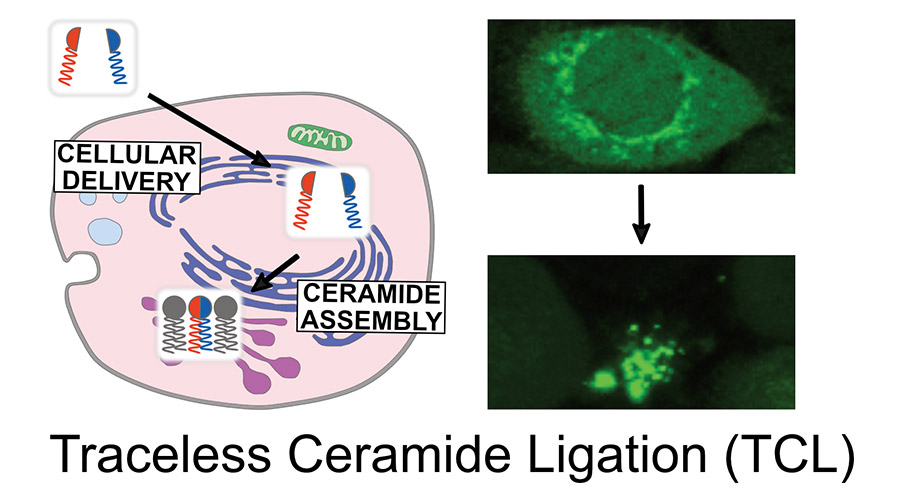UC San Diego Chemists Develop New Strategy for ‘Hard-to-Study’ Lipids
Published Date
By:
- Cynthia Dillon
Share This:
Article Content

Graphic (left) depicts the general process of applying TCL to a cell; images (right) exhibit generated ceramides applied to trigger cell death. Images courtesy of Neal Devaraj
Ceramides—waxy, oily lipid molecules that affect biological function like insulin resistance, gene regulation and tumor suppression—could be applied to new cancer treatments…if only scientists could study them directly in living organisms. Tackling this task with a brand of chemistry that addresses biological challenges, University of California San Diego Professor Neal Devaraj produced research results that confront the limitations of studying ceramides.
In an article written with doctoral candidate Andrew Rudd and published recently in Proceedings of the National Academy of Sciences, Devaraj offers a new scientific approach to more directly studying ceramides in living cells. Using chemical synthesis termed “traceless ceramide ligation” (TCL) to synthesize certain lipids (fats and oils in the body that store energy and surround every body cell), the UC San Diego chemists developed a strategy that enables controlled delivery of specific, full-length ceramides to cells, which is necessary for understanding their specific biological effects.
According to the UC San Diego Department of Chemistry & Biochemistry professor and new Blavatnik National Laureate in Chemistry, ceramides are unable to penetrate cell membranes “so simply adding them to living cells is not useful.” Devaraj said that TCL allowed him and Rudd to investigate the role of ceramide structure and to demonstrate that ceramide saturation is an important modulator of ceramide-driven cell death.
“Studying ceramide-driven cell death can help us to better understand the mechanisms behind cell death and perhaps lead to novel methods for triggering cell-specific death in diseases such as cancer,” explained Devaraj. “Our process sneaks across two cell permeable building blocks that assemble into a ceramide once in the cell.”
According to Rudd, scientists know that the cell contains hundreds of different lipids species, but they understand very little about what lipids actually do. “Using chemistry-based approaches, we hope to discover the function of specific lipids and determine their roles in human health and disease.”
Devaraj added that future studies using TCL will prove helpful in understanding the metabolism of in situ-generated ceramides and their effects on endogenous (internal) lipid levels. “Furthermore, application of our approach to other lipids may facilitate the study of this often intractable class of biomolecules.”
This work was supported by the NSF (grant CHE-1254611) and the NIH (grants DP2DK111801 and CA009523).
At UC San Diego, our faculty members aren’t afraid to tackle big ideas that will help solve some of the world’s most pressing problems including disease, climate change, global security and more.
Share This:
You May Also Like
Stay in the Know
Keep up with all the latest from UC San Diego. Subscribe to the newsletter today.



